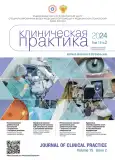The effect of intravitreal antiangiogenic diabetic macular edema treatment on the corneal endothelium cell count
- Authors: Amirkulieva R.N.1, Khomyakova E.N.1, Loskutov I.A.1, Agammedov M.B.1
-
Affiliations:
- Moscow Regional Research and Clinical Institute
- Issue: Vol 15, No 2 (2024)
- Pages: 20-28
- Section: Original Study Articles
- URL: https://journals.rcsi.science/clinpractice/article/view/262722
- DOI: https://doi.org/10.17816/clinpract626774
- ID: 262722
Cite item
Full Text
Abstract
BACKGROUND: Antiangiogenic treatment of diabetic macular edema is a first-line therapy in modern ophthalmology. Novel antiangiogenic drugs are increasingly being developed to improve treatment results and solve certain issues. However, owing to the advent of new drugs, more questions arise about their effect on the patient’s retina and other structures of the eye, such as the cornea.
AIM: The study aimed to investigate the effect of intravitreal administration of the anti-VEGF drug brolucizumab on the corneal endothelium in patients with diabetic macular edema.
METHODS: 106 patients (106 eyes) were included in the prospective study: 31 men and 75 women. The main group consisted of 56 patients (56 eyes) were included in the prospective study: 14 men and 42 women with different stages of diabetic retinopathy with diabetic macular edema, the average age of patients was 62.2±8.4 years. The average number of endothelial cells per 1 mm2 in these patients before the loading dose of brolucizumab was 2378.9±393.3 cl/mm2. The control group included 50 patients (50 eyes) without diabetes who did not receive intravitreal injections or any other surgical interventions on the examined eye for 1 year. All patients underwent endothelial microscopy using the Tomey EM-4000 endothelial microscope (REN 2017/6294), estimated: CD (the number of endothelial cells per 1 mm2); CCT (the central thickness of the cornea, microns); CV (the coefficient of variation, %); 6A (the proportion of hexagonal cells, %). All study participants received intravitreal injections of brolucizumab in a volume of 0.05 ml (5 injections with an interval of 6 weeks).
RESULTS: In the main group before intravitreal injections, the indices of the central corneal thickness and the number of endothelial cells per 1 mm2 were 549.7±30.1 microns and 2378.9±393.3 cells/mm2, respectively. After a course of antiangiogenic diabetic macular edema therapy, the central thickness of the cornea was 548.2±30.6 microns, and the number of endothelial cells per 1 mm2 was 2382.3±424.9 cells/mm2. The indicators CV (coefficient of variability, %) and 6A (proportion of hexagonal cells, %) before the start of intravitreal injections were 36.9±5% and 46.8±6.3%, respectively, after the introduction of the loading dose drugs, the average values were 37.9±4.3% and 45.8±6.3%. Changes in all indicators were not static significant.
CONCLUSION: The use of brolucizumab as therapy in patients with diabetic macular edema did not cause a negative effect on the cornea, there were no statistically significant changes in the central thickness of the cornea, the number of endothelial cells per 1 mm2, the coefficient of variation and the proportion of hexagonal cells.
Full Text
##article.viewOnOriginalSite##About the authors
Regina N. Amirkulieva
Moscow Regional Research and Clinical Institute
Author for correspondence.
Email: regina-amirkulieva@yandex.ru
ORCID iD: 0009-0008-5562-0561
Graduate Student, Junior Research Associate
Russian Federation, MoscowElena N. Khomyakova
Moscow Regional Research and Clinical Institute
Email: veritas.elena@gmail.com
ORCID iD: 0000-0002-4460-3968
SPIN-code: 2200-0320
MD, PhD, Associate Professor
Russian Federation, MoscowIgor A. Loskutov
Moscow Regional Research and Clinical Institute
Email: loskoutigor@mail.ru
ORCID iD: 0000-0003-0057-3338
SPIN-code: 5845-6058
MD, PhD
Russian Federation, MoscowMushviq B. Agammedov
Moscow Regional Research and Clinical Institute
Email: mushviqagammedov@mail.ru
ORCID iD: 0000-0001-6665-5657
MD, PhD
Russian Federation, MoscowReferences
- Lazzaro DR, McFarlane SI. Diabetes: Current and future developments. Vol. 2. Diabetes and the Eye: Latest Concepts and Practices; 2021. P. 4–5.
- Smeringaiova I, Merjava RS, Stranak Z, et al. Endothelial wound repair of the organ-cultured porcine corneas. Current Eye Research. 2018;43(7):856–865. doi: 10.1080/02713683.2018.1458883
- Mortazavi SA, Akhlaghi M, Dehghani A, et al. Diabetic retinopathy and corneal endothelial parameters: An analytical cross-sectional study. BMC Ophthalmol. 2022;22(1):427. EDN: BUQKDQ doi: 10.1186/s12886-022-02667-6
- Canan H, Sahinoglu-Keskek N, Altan-Yaycioglu R. The relationship of central corneal thickness with the status of diabetic retinopathy. BMC Ophthalmol. 2020;20(1):220. EDN: RBAUQL doi: 10.1186/s12886-020-01411-2
- Ozdamar Ya, Cankaya B, Ozalp S, et al. Is there a correlation between diabetes mellitus and central corneal thickness? J Glaucoma. 2010;19(9):613–616. doi: 10.1097/IJG.0b013e3181ca7c62
- Gharbiya M, Bruscolini A, Sacchetti M, et al. In vivo antivascular endothelial growth factor treatment induces corneal endothelium apoptosis in rabbits through changes in p75NTR-proNGF pathway. J Cell Physiol. 2018;233(11): 8874–8883. EDN: HFWGVF doi: 10.1002/jcp.26806
- Qi YY, Zhang F, Chun-Shi LI, et al. Effect of repeated intravitreal anti-vascular endothelial growth factor drugs on corneal endothelium [04 Jan 2023]. Version 1. doi: 10.21203/rs.3.rs-2390768/v1
- Ari S, Nergiz Y, Aksit I, et al. Evaluation of intracameral injection of ranibizumab and bevacizumab on the corneal endothelium by scanning electron microscopy. J Ocul Pharmacol Ther. 2015;31(2):100–105. doi: 10.1089/jop.2014.0005
- Joshi M, Naik MP, Sarkar L. Effect of intravitreal anti-vascular endothelial growth factor on corneal endothelial cell count and central corneal thickness in Indian population. J Family Med Prim Care. 2019;8(7):2429–2432. doi: 10.4103/jfmpc.jfmpc_314_19
- Arslan GD, Guven D, Alkan AA, et al. Short term effects of intravitreal anti-vascular endothelial growth factor agents on cornea, anterior chamber, and intraocular pressure. Cutan Ocul Toxicol. 2019;38(4):344–348. doi: 10.1080/15569527.2019.1616749
- Guzel H, Bakbak B, Koylu MT, et al. The effect and safety of intravitreal injection of ranibizumab and bevacizumab on the corneal endothelium in the treatment of diabetic macular edema. Cutan Ocul Toxicol. 2017;36(1):5–8. doi: 10.3109/15569527.2016
- Qi Y, Li C, Ye S, et al. Long-term dynamic changes and influencing factors of corneal morphology after multiple intravitreal injections of anti-VEGF drugs. Medicine (Baltimore). 2024;103(17):e37937. doi: 10.1097/MD.0000000000037937
- Clyne AM. Endothelial response to glucose: Dysfunction, metabolism, and transport. Biochem Soc Trans. 2021;49(1): 313–325. EDN: VIYYFS doi: 10.1042/BST20200611
- Лоскутов И.А., Хомякова Е.Н. Диабетическая ретинопатия, диабетический макулярный отек: как достичь регресса. Руководство для врачей. Москва: ГЭОТАР-Медиа, 2023. 264 с. [Loskutov IA, Khomyakova EN. Diabetic retinopathy, diabetic macular oedema: How to achieve regression. A guide for physicians. Moscow: GEOTAR-Media; 2023. 264 р. (In Russ).] doi: 10.33029/9704-7553-DMO-2023-1-264
Supplementary files







